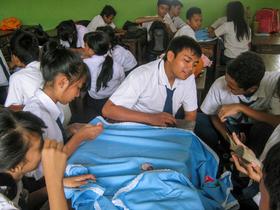Top Rankings
Bangor Public Schools ranks among the top 20% of public school district in Maine for:
Category
Attribute
Graduation Rate
Highest graduation rate (Top 20%)
Diversity
Most diverse schools (Top 1%)
Community Size
Largest student body (number of students) (Top 1%)
For the 2025-26 school year, there are 5 public preschools serving 1,138 students in Bangor Public Schools. This district's average pre testing ranking is 6/10, which is in the top 50% of public pre schools in Maine.
Public Preschools in Bangor Public Schools have an average math proficiency score of 71% (versus the Maine public pre school average of 52%), and reading proficiency score of 81% (versus the 82% statewide average).
Minority enrollment is 22% of the student body (majority Hispanic and Asian), which is more than the Maine public preschool average of 14% (majority Black).
Overview
This School District
This State (ME)
# Schools
10 Schools
259 Schools
# Students
3,434 Students
59,048 Students
# Teachers
277 Teachers
5,438 Teachers
Student-Teacher Ratio
12:1
12:1
Student By Grade
District Rank
Bangor Public Schools, which is ranked within the top 30% of all 182 school districts in Maine (based off of combined math and reading proficiency testing data) for the 2022-2023 school year.
The school district's graduation rate of 90% has increased from 85% over five school years.
Overall District Rank
#42 out of 189 school districts
(Top 30%)
(Top 30%)
Math Test Scores (% Proficient)
58%
49%
Reading/Language Arts Test Scores (% Proficient)
87%
84%
Science Test Scores (% Proficient)
45%
37%
Graduation Rate
90%
86%
Students by Ethnicity:
Diversity Score
0.36
0.26
% American Indian
1%
1%
% Asian
3%
1%
% Hispanic
6%
3%
% Black
3%
5%
% White
79%
86%
% Hawaiian
n/a
n/a
% Two or more races
8%
4%
All Ethnic Groups
District Revenue and Spending
The revenue/student of $18,555 in this school district is less than the state median of $21,600. The school district revenue/student has stayed relatively flat over four school years.
The school district's spending/student of $18,416 is less than the state median of $21,191. The school district spending/student has stayed relatively flat over four school years.
Total Revenue
$64 MM
$3,617 MM
Spending
$63 MM
$3,549 MM
Revenue / Student
$18,555
$21,600
Spending / Student
$18,416
$21,191
Best Bangor Public Schools Public Preschools (2025-26)
School
(Math and Reading Proficiency)
(Math and Reading Proficiency)
Location
Quick Facts
Rank: #11.
Fruit Street School
(Math: 80-84% | Reading: 85-89%)
Rank:
Rank:
9/
Top 20%10
175 Fruit Street
Bangor, ME 04401
(207) 941-6270
Bangor, ME 04401
(207) 941-6270
Gr: PK-3 | 322 students Student-teacher ratio: 15:1 Minority enrollment: 23%
Rank: #22.
Vine Street School
(Math: 60-69% | Reading: 80-89%)
Rank:
Rank:
8/
Top 30%10
66 Vine Street
Bangor, ME 04401
(207) 941-6300
Bangor, ME 04401
(207) 941-6300
Gr: PK-3 | 176 students Student-teacher ratio: 10:1 Minority enrollment: 19%
Rank: #33.
Fourteenth Street School
(Math: ≥90% | Reading: ≥80%)
Rank:
Rank:
7/
Top 50%10
224 Fourteenth Street
Bangor, ME 04401
(207) 941-6350
Bangor, ME 04401
(207) 941-6350
Gr: PK-3 | 153 students Student-teacher ratio: 13:1 Minority enrollment: 18%
Rank: #44.
Abraham Lincoln School
(Math: 70-79% | Reading: 70-79%)
Rank:
Rank:
6/
Top 50%10
45 Forest Avenue
Bangor, ME 04401
(207) 941-6280
Bangor, ME 04401
(207) 941-6280
Gr: PK-3 | 176 students Student-teacher ratio: 12:1 Minority enrollment: 26%
Rank: #55.
Downeast School
(Math: 45-49% | Reading: 70-79%)
Rank:
Rank:
3/
Bottom 50%10
100 Moosehead Blvd
Bangor, ME 04401
(207) 941-6240
Bangor, ME 04401
(207) 941-6240
Gr: PK-3 | 311 students Student-teacher ratio: 12:1 Minority enrollment: 23%
Recent Articles

School Vouchers: Updated Pros and Cons (2025 Review)
Comprehensive 2025 analysis of school vouchers, weighing benefits and challenges for families, funding, outcomes, and policy directions.

Benefits and Drawbacks of Homework in 2025
Explore updated 2025 insights on homework鈥檚 benefits, drawbacks, mental health impact, best practices, and policy trends in U.S. public schools.

Charter Schools vs Public Schools 2025: Key Differences & Trends
Explore updated 2025 insights comparing charter schools vs public schools, enrollment, academic outcomes, funding, and real-world examples for families and educators.





